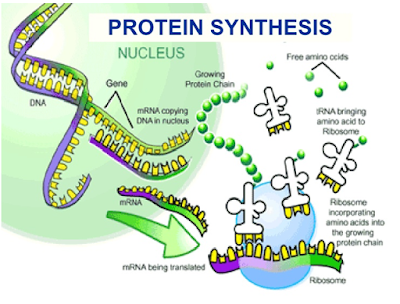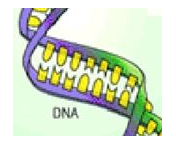Protein synthesis is the process by which the genetic code puts together
proteins in a cell. Proteins are the building blocks of the body as they form our enzymes (that control for bodily processes) and hard and soft tissues (that make up the framework of the body), This is an incredibly important process that occurs within the body, as well as a fairly complex one given then number of bodily structures and functions required.
For protein
synthesis to take place there are key parts of the body that must work
together, and these key parts are Deoxyribonucleic
acid (DNA) & two types of ribonucleic acid (RNA): messenger RNA
(mRNA) and transport RNA (tRNA). DNA is the molecule that carries the genetic code. mRNA is the
molecule that carries the genetic code out of the nucleus for translation into
proteins, whereas tRNA is RNA that lines up amino acids along
mRNA to make up proteins.
So with these definitions in mind, a greater understanding of how protein
synthesis works can be gained, which will be useful in completing the protein
synthesis section of the lab. I have
broken the process down into numeric steps and will refer back to the
definitions provided above:
- DNA unwinds and polymerase (an enzyme) unzips the bonded base pairs. Remember that DNA carries the genetic code, and that genes are the portion of the DNA molecule that codes for a specific protein.
Figure 1: DNA being unwrapped and
divided by polymerase
2
- Once the DNA has been unwrapped and the base pair divided from each other, mRNA approaches one side of the unwrapped DNA molecule and read the base pairs. It matches it corresponding bases with that DNA. Remember that with DNA Cytosine matches with Guanine (and vice versa) and Adenine with Thymine (and vice versa). One way to remember this is cars are to garages as apples are to trees. All RNA strands have different base pairs, so Adenine matches with Uracil (and vice versa), while Cytosine still matches with Guanine (and vice versa). If you are familiar with the chemical symbol for gold (Au) then you can remember this match.
Figure 2: mRNA matches its
corresponding bases with DNA.
- Once the mRNA has collected the genetic information from the DNA it then leave the nucleus of the cell (where DNA is located) and travels to a different part of the cell. Remember the definition of mRNA is that it is the molecule that carries the genetic code out of the nucleus for translation into proteins.
Figure 3: mRNA leaves the nucleus
of the cell after collecting the genetic information from DNA.
- Outside of the nucleus of the cell the mRNA meets with a ribosome, which is another feature in the cell, and the ribosome holds it in place. Transfer RNA (tRNA) then brings its corresponding bases to the mRNA in order to build the amino acids. The amino acids, when put together, form a chain that builds a specific protein.
Figure 4: mRNA is read by the
tRNA, which builds the amino acids.
Now remember that genes code for proteins, and proteins are
composed of a series of amino acids. So
for the lab you have to have DNA, which is read by mRNA. mRNA is read by tRNA, but it is the code
collected by mRNA that determines which amino acids is built.
Figure 5: Process of
Protein Synthesis
DNA --> mRNA --> tRNA Amino Acid
Stein, P.L. & Rowe, B.M. (2014). Introduction to Human Evolution and
Prehistory. United
States of
America: McGraw Hill Education.






20 comments:
I am still a little confused so is this the process that helps people grow?
Yes, somatic cells, or cells that an organism is made up, undergo protein synthesis in order to repair and grow the body. So when you were growing up (big and tall) your body's bone, skin, and muscle cells were going through protein synthesis. The same occurs if you cut yourself and the body needs to repair itself. :)
Aaliyah Caldwell
Awkwardly, I don't think i learned about this is biology. i was confused too until i read your comment above. I didnt know about protein synthesis and they it helps you grow.
I remember learning this in biology class and we even went to the computer lab where we unzip the strands and build new ones it was kinda like a typing game.
I vaguely remember learning this in high school. But that's awesome that so much goes on in your body that you don't know about or have to think about.
This has been an eye opener for me as well. Who would've ever thought that your body is working that hard to help you grow.
I've taken Biology twice sadly and I'm just now understanding the concept that it is a form of a repair mechanism. The label "Building Blocks" is a suitable definition in regards to the duty of it.
I actually just recently studied protein synthesis ion my Bio 101 class but even though i understood i then I feel like after reading this article i have allowed myself to achieve a better level of understanding based off the post.
I remember learning about this in my high school biology class. We even had neat learning games to help us fully understand how it works. It's amazing though how every time I relearn it in different classes, there's always seems to be something new that I had either missed or forgotten about. - Shannon
I never really understand this topic even when I had biology class in high school.
we learned this In high school and once we collected our own DNA.
I learned about this my senior year of high school and reading this blog brought so many memories back. Building Protein Synthesis was my favorite experiment we did in biology.
Jovie Black
Before taking an biology course in high school, I never knew how much stuff was in the human body working together. This stuff never gets old !
LaTroya "Trey" Jamison
I'm not sure why I can't remember, but how detrimental is it if a base pair is not paired correctly?
Its crazy how one tiny mix up can cause a mutation within the strand.
You can learn a lot from this post. It's crazy that there is this much science behind DNA and proteins in the body.
DNA codes for all proteins in the body, this is something I am now learning in my biology class. I find this information very useful and very factual.
How is it that people of the same genetics can fluctuate in height and weight? My brother and I are very different height and weights, yet we share the same DNA. Im just so in awe of how the body works like that!
The human body is truly amazing. The fact that it has to go through protein synthesis to grow the body in every way. Understanding DNA from a cellular level is so interesting yet confusing at the same time. It would be super interesting to collect our own DNA and look at it!
Makayla Peterman
It really does seem like something our of scifi. Its crazy to think of how much work goes into something a simple as cell regeneration. Also how much we take for granted. All of this work is one of the reasons why proper nutrition and caloric intake is so important.
Post a Comment